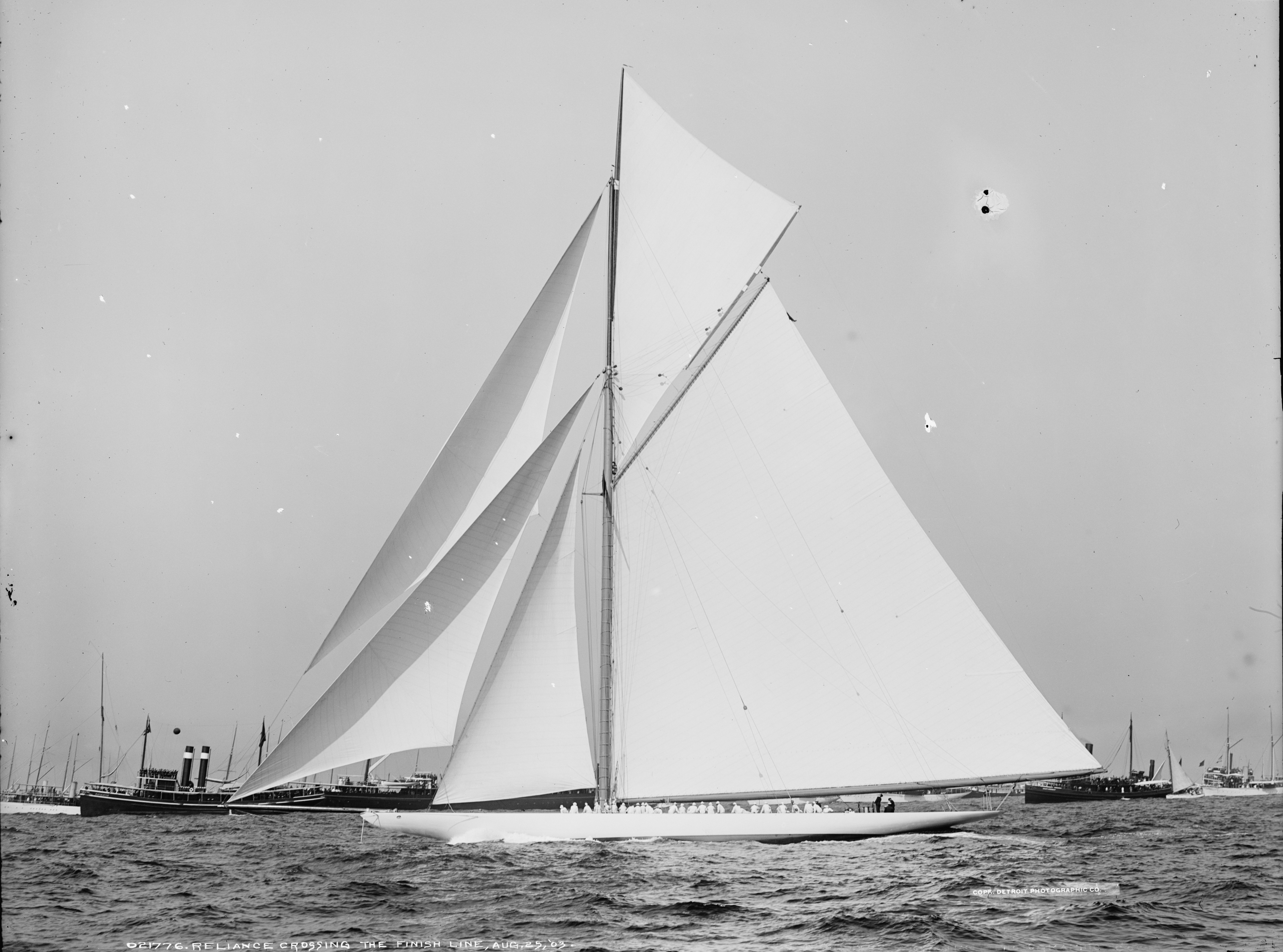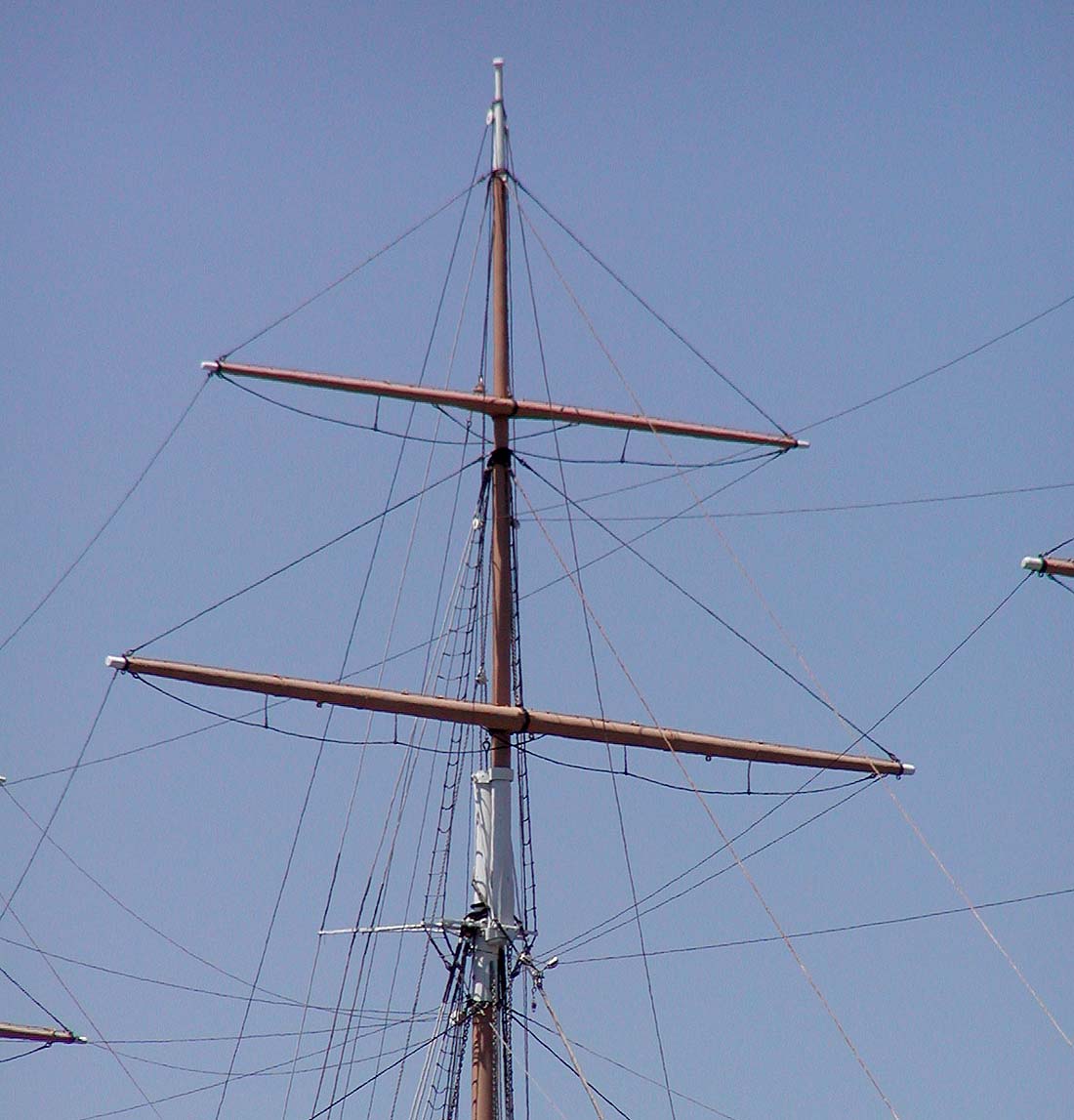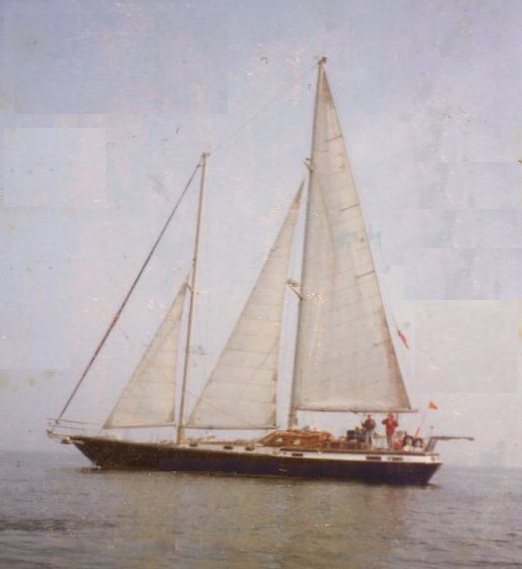|
Rig (sailing)
A sailing vessel's rig is its arrangement of Mast (sailing), masts, sails and rigging. Examples include a schooner rig, cutter rig, junk rig, etc. A rig may be broadly categorized as Fore-and-aft rig, "fore-and-aft", Square rig, "square", or a combination of both. Within the fore-and-aft category there is a variety of triangular and quadrilateral sail shapes. Spar (sailing), Spars or Sail batten, battens may be used to help shape a given kind of sail. Each rig may be described with a sail plan—formally, a drawing of a vessel, viewed from the side. Modern examples of single-person sailing craft, such as Windsurfing, windsurfers, Iceboat, iceboats, and Land sailing, land-sailing craft, typically have uncomplicated rigs with a single sail on a mast with a boom. Introduction In the English language, ships were usually described, until the end of the eighteenth century, in terms of their type of hull design. Using the type of rig as the main type identifier for a vessel became com ... [...More Info...] [...Related Items...] OR: [Wikipedia] [Google] [Baidu] |
Tackling
Tackle may refer to: * In football: ** Tackle (football move), a play in various forms of football ** Tackle (gridiron football position), a position in American football and Canadian football ** Dump tackle, a forceful move in rugby of picking up an opposing player and throwing them to the ground ** The Tackle, a term for the final play of Super Bowl XXXIV ** Sliding tackle, a tackle in association football * Fishing tackle, the gear or equipment used when fishing * An assembly of pulleys with a rope threaded through them; see block and tackle * Tackle (Transformers), a fictional character {{disambig ... [...More Info...] [...Related Items...] OR: [Wikipedia] [Google] [Baidu] |
Spritsail
The spritsail is a four-sided, fore-and-aft sail that is supported at its highest points by the mast and a diagonally running spar known as the sprit. The foot of the sail can be stretched by a boom or held loose-footed just by its sheets. A spritsail has four corners: the throat, peak, clew, and tack. The Spritsail can also be used to describe a rig that uses a spritsail. Historically, spritsails were the first European fore-and-aft rigs, appearing in Greco-Roman navigation in the 2nd century BC. The rig The luff of the sail is bound to the mast, but unlike the gaff rig where the head is bound to a spar, this rig supports the leech of the sail by means of a diagonal spar or spars named a sprit ( ). The forward end of the sprit spar is attached to the mast, with the after end of the sprit spar attached to the peak. The sprit is steadied and controlled from the deck by a pair of wire vangs ( ) attached to the peak of the sail. It is said to be the ancestor of the ... [...More Info...] [...Related Items...] OR: [Wikipedia] [Google] [Baidu] |
Gaff-rig
Gaff rig is a sailing rig (configuration of sails, mast and stays) in which the sail is four-cornered, fore-and-aft rigged, controlled at its peak and, usually, its entire head by a spar (pole) called the ''gaff''. Because of the size and shape of the sail, a gaff rig will have running backstays rather than permanent backstays. The gaff enables a fore-and-aft sail to be four sided, rather than triangular. A gaff rig typically carries 25 percent more sail than an equivalent Bermuda rig for a given hull design. A sail hoisted from a gaff is called a gaff-rigged sail. Description Gaff rig remains the most popular fore-aft rig for schooner and barquentine mainsails and other course sails, and spanker sails on a square rigged vessel are always gaff rigged. On other rigs, particularly the sloop, ketch and yawl, gaff rigged sails were once common but have now been largely replaced by the Bermuda rig sail, which, in addition to being simpler than the gaff rig, usually all ... [...More Info...] [...Related Items...] OR: [Wikipedia] [Google] [Baidu] |
Gennaker
A gennaker is a sail that was developed before the 1980s. Used when sailing downwind, it is a cross between a genoa and a spinnaker. It is not symmetric like a true spinnaker but is asymmetric like a genoa, but the gennaker is not attached to the forestay like a jib or genoa. The gennaker is rigged like a spinnaker but the tack is fastened to the hull or to a bowsprit. It has greater camber than a genoa (but significantly less camber than a spinnaker). This is optimal for generating lift at larger angles of attack. An early form of gennaker was the "gollywhomper", used briefly in the 1870s. The gennaker is a specialty sail primarily used on racing In sports, racing is a competition of speed, in which competitors try to complete a given task in the shortest amount of time. Typically this involves traversing some distance, but it can be any other task involving speed to reach a specific g ... boats to bridge the performance gap between a genoa and a spinnaker. It is ... [...More Info...] [...Related Items...] OR: [Wikipedia] [Google] [Baidu] |
Spinnaker
A spinnaker is a sail designed specifically for sailing off the wind on courses between a Point of sail#Reaching, reach (wind at 90° to the course) to Point of sail#Running downwind, downwind (course in the same direction as the wind). Spinnakers are constructed of lightweight fabric, usually nylon, and are often brightly colored. They may be designed to perform best as either a reaching or a running spinnaker, by the shaping of the panels and seams. They are attached at only three points and said to be ''flown''. Etymology Some dictionaries suggest that the origin of the word could be traced to the first boat to commonly fly a spinnaker, a yacht called ''Sphinx'', mispronounced as ''Spinx''. ''Spinnaker'' entry in The Concise Oxford Dictionary of English Etymology (1996). Oxford University PressAccording to encyclopedia.com Both retrieved on 20 July 2008. ''Sphinx'' first set her spinnaker in the Solent in 1865, and the first recorded use of the word was in 1866 in the Augu ... [...More Info...] [...Related Items...] OR: [Wikipedia] [Google] [Baidu] |
Bowsprit
The bowsprit of a sailing vessel is a spar (sailing), spar extending forward from the vessel's prow. The bowsprit is typically held down by a bobstay that counteracts the forces from the forestay, forestays. The bowsprit’s purpose is to create anchor points for the sails that extend beyond the vessel’s bow, increasing the size of sail that may be held taut. The word ''bowsprit'' is thought to originate from the Middle Low German word ''bōchsprēt'' – ''bōch'' meaning "bow" and ''sprēt'' meaning "pole". On some square-rigged ships a Spritsail (square-rigged), spritsail is flown below the bowsprit; these are sometimes accompanied by a sprit topmast, which serves to assist the spritsail while tacking (sailing), tacking. The bowsprit may also be used to hold up the Figurehead (object), figurehead. References External links * {{Sailing ship elements Sailboat components ... [...More Info...] [...Related Items...] OR: [Wikipedia] [Google] [Baidu] |
Mast (sailing)
The mast of a sailing vessel is a tall spar, or arrangement of spars, erected more or less vertically on the median line of a ship or boat. Its purposes include carrying sails, spars, and derricks, giving necessary height to a navigation light, look-out position, signal yard, control position, radio aerial, or signal lamp. Large ships have several masts, with the size and configuration depending on the style of ship. Nearly all sailing masts are guyed. Until the mid-19th century, all vessels' masts were made of wood formed from a single or several pieces of timber which typically consisted of the trunk of a conifer tree. From the 16th century, vessels were often built of a size requiring masts taller and thicker than from single tree trunks. On these larger vessels, to achieve the required height, the masts were built from up to four sections (also called masts). From lowest to highest, these were called: lower, top, topgallant, and royal masts. Giving the lower section ... [...More Info...] [...Related Items...] OR: [Wikipedia] [Google] [Baidu] |
Stays (nautical)
Stays are ropes, wires, or rods on sailing Sailing employs the wind—acting on sails, wingsails or kites—to propel a craft on the surface of the ''water'' (sailing ship, sailboat, raft, Windsurfing, windsurfer, or Kitesurfing, kitesurfer), on ''ice'' (iceboat) or on ''land'' (Land sa ... vessels that run fore-and-aft along the centerline from the masts to the hull, deck, bowsprit, or to other masts which serve to stabilize the masts. A stay is part of the standing rigging and is used to hold a mast upright. It is a large strong rope, wire or rod extending from the upper end of each mast and running down towards the deck of the vessel in a midships -and- direction. The shrouds serve a similar function but extend on each side of the mast and provide support in the athwartships direction. The object of both is to prevent the masts from falling down but the stays also prevent springing, when the ship is pitching deep. Thus stays are fore and aft. Those led aft ... [...More Info...] [...Related Items...] OR: [Wikipedia] [Google] [Baidu] |
Parts Of A Sail
Sail components include the features that define a sail's shape and function, plus its constituent parts from which it is manufactured. A sail may be classified in a variety of ways, including by its orientation to the vessel (e.g. ''fore-and-aft'') and its shape, (e.g. ''(a)symmetrical'', ''triangular'', ''quadrilateral'', etc.). Sails are typically constructed out of flexible material that is shaped by various means, while in use, to offer an appropriate airfoil, according to the strength and apparent direction of the wind. A variety of features and fittings allow the sail to be attached to lines and spars. Whereas conventional sails form an airfoil with one layer of fabric, wingsails comprise a structure that has material on both sides to form an airfoil—much like a wing placed vertically on the vessel—and are beyond the scope of this article. Classifications Sails may be classified as either ''triangular'', which describes sails that either come to one point of suspen ... [...More Info...] [...Related Items...] OR: [Wikipedia] [Google] [Baidu] |
Staysail
A staysail ("stays'l") is a fore-and-aft rigged sail whose luff can be affixed to a stay running forward (and most often but not always downwards) from a mast to the deck, the bowsprit, or to another mast. Description Most staysails are triangular; however, some are four-cornered, notably some fisherman's staysails. Triangular staysails set forward of the foremost mast are called jibs, headsails, or foresails. The innermost such sail on a cutter, schooner, and many other rigs having two or more foresails is referred to simply as ''the staysail'', while the others are referred to as jibs, flying jibs, etc. Types of staysail include the tallboy staysail (a narrow staysail carried between the spinnaker and the mainsail on racing yachts), the genoa staysail (a larger one carried inside the spinnaker when broad reaching), and the bigboy staysail (another name for the shooter or blooper, carried on the leeward side of the spinnaker). Unlike the cutter staysail, none of ... [...More Info...] [...Related Items...] OR: [Wikipedia] [Google] [Baidu] |
Yard (sailing)
A yard is a spar (sailing), spar on a mast (sailing), mast from which sails are set. It may be constructed of timber or steel or from more modern materials such as aluminium or carbon fibre. Although some types of fore and aft rigs have yards, the term is usually used to describe the horizontal spars used on square rigged sails. In addition, for some decades after square sails were generally dispensed with, some yards were retained for deploying wireless (radio) aerials and signal flags. Parts of the yard ; Bunt : The short section of the yard between the ''slings'' that attach it to the mast. ; Quarters : The port and starboard quarters form the bulk of the yard, extending from the slings to the fittings for the lifts and braces (sailing), braces. ; Yardarms : The outermost tips of the yard: outboard from the attachments for the lifts. Note that these terms refer to stretches of the same spar, not to separate component parts. Controlling the yard The yard can rotate aro ... [...More Info...] [...Related Items...] OR: [Wikipedia] [Google] [Baidu] |
Barque
A barque, barc, or bark is a type of sailing ship, sailing vessel with three or more mast (sailing), masts of which the fore mast, mainmast, and any additional masts are Square rig, rigged square, and only the aftmost mast (mizzen in three-masted barques) is Fore-and-aft rig, rigged fore and aft. Sometimes, the mizzen is only partly fore-and-aft rigged, bearing a square-rigged sail above. Etymology The word "barque" entered English via the French term, which in turn came from the Latin language, Latin ''barca'' by way of Occitan language, Occitan, Catalan language, Catalan, Spanish, or Italian. The Latin may stem from Celtic language, Celtic ''barc'' (per Rudolf Thurneysen, Thurneysen) or Greek ''baris'' (per Friedrich Christian Diez, Diez), a term for an Egyptian boat. The ''Oxford English Dictionary'', however, considers the latter improbable. The word ''barc'' appears to have come from Celtic languages. The form adopted by English, perhaps from Irish language, Irish, was ... [...More Info...] [...Related Items...] OR: [Wikipedia] [Google] [Baidu] |






